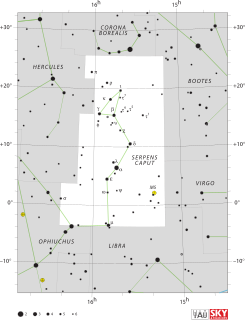 W
WSerpens is a constellation of the northern hemisphere. One of the 48 constellations listed by the 2nd-century astronomer Ptolemy, it remains one of the 88 modern constellations defined by the International Astronomical Union. It is unique among the modern constellations in being split into two non-contiguous parts, Serpens Caput to the west and Serpens Cauda to the east. Between these two halves lies the constellation of Ophiuchus, the "Serpent-Bearer". In figurative representations, the body of the serpent is represented as passing behind Ophiuchus between Mu Serpentis in Serpens Caput and Nu Serpentis in Serpens Cauda.
 W
W3C 321 is a system of two galaxies rotating around each other. They are notable for showing the first observed galaxy smiting another galaxy with a blast of energy, which is theorized to be from a supermassive black hole at the center of the former galaxy.
 W
W25 Serpentis is a star system in the constellation of Serpens Caput. With an apparent magnitude of 5.37, it is just barely visible to the naked eye. The system is estimated to be some 450 light-years based on its parallax.
 W
WAlpha Serpentis, formally named Unukalhai, is a double star in the head of the equatorial constellation of Serpens. With an apparent visual magnitude of 2.6, this star is the brightest in the constellation and it can be viewed with the naked eye from most of the Earth. Parallax measurements yield an estimated distance of about 74 light-years from the Sun.
 W
WArp 220 is the result of a collision between two galaxies which are now in the process of merging. It is the 220th object in Halton Arp's Atlas of Peculiar Galaxies.
 W
WBeta Serpentis, Latinized from β Serpentis, is a binary star system in the constellation Serpens, in its head. It is visible to the naked eye with a combined apparent visual magnitude of +3.65. Based upon an annual parallax shift of 21.03 mas as seen from Earth, it is located around 155 light years from the Sun. The system is a member of the Ursa Major Moving Group.
 W
WCOROT-9b is an exoplanet orbiting the star COROT-9, approximately 1500 light years away in the constellation Serpens. COROT-9b's distance of nearest approach to its parent star of approximately 0.36 AU was the largest of all known transiting planets at the time of its discovery, with an orbital period of 95 days. The transit of this planet lasts 8 hours. The planet is at a distance from its star where there is a strong increase in albedo as the temperature decreases, because of the condensation of reflective water clouds in the atmosphere. This suggests its atmosphere may be locked into one of two states: a cloudless state with temperatures between 380 K and 430 K, or covered in water clouds with a temperature in the range 250 K to 290 K.
 W
WThe Eagle Nebula is a young open cluster of stars in the constellation Serpens, discovered by Jean-Philippe de Cheseaux in 1745–46. Both the "Eagle" and the "Star Queen" refer to visual impressions of the dark silhouette near the center of the nebula, an area made famous as the "Pillars of Creation" imaged by the Hubble Space Telescope. The nebula contains several active star-forming gas and dust regions, including the aforementioned Pillars of Creation.
 W
WEta Serpentis is a star in the constellation Serpens. In particular, it lies in Serpens Cauda, the snake's tail. The star has an apparent visual magnitude of 3.260, making it visible to the naked eye. Parallax measurements give a distance estimate of 60.5 light-years from the Earth.
 W
WFH Serpentis was a nova, which appeared in the constellation Serpens in 1970. It reached magnitude 4.4. It was discovered on February 13, 1970 by Minoru Honda located at Kurashiki, Japan. Other astronomers later studied this Nova, and calculated its distances based on the decay time of its light curves.
 W
WHoag's Object is a non-typical galaxy of the type known as a ring galaxy. The galaxy is named after Arthur Hoag who discovered it in 1950 and identified it as either a planetary nebula or a peculiar galaxy with eight billion stars, spanning roughly 100,000 light years.
 W
WIC 4703 is the diffuse emission nebula or HII region associated with Messier 16, which is actually a cluster of stars. It is the nebulous region surrounding Messier 16. These two objects make up the Eagle Nebula. They are relatively bright and are located in the constellation Serpens Cauda. This region contains the picturesque Pillars of Creation. This is an active star forming region 7,000 light years away. It is approximately magnitude 8. The cluster was discovered by Jean-Philippe Loys de Cheseaux, but Charles Messier later rediscovered it and remarked on its apparent nebulous appearance. The cluster is estimated to be 5.5 million years old, and the nebula would be a bit older. The nebula is about 55 x 70 light years. The Eagle Nebula lies in the Sagittarius Arm of the Milky Way.
 W
WIC 4756 is a large bright open cluster in the constellation Serpens. Known as Graff's Cluster, it is bright enough to be seen with the naked eye and considered a fine cluster for binoculars or small telescopes.
 W
Wι Serpentis, Latinized as Iota Serpentis and abbreviated Iot Ser, is a triple star system in the constellation Serpens, in its head. It is approximately 190 light years from Earth.
 W
WLambda Serpentis is a star in the constellation Serpens, in its head. It has an apparent visual magnitude of 4.43, making it visible to the naked eye. Based upon parallax measurements from the Hipparcos satellite, this star lies at a distance of about 39.5 light-years from Earth. This star is larger and more massive than the Sun, although it has a similar stellar classification. It is shining with nearly double the Sun's luminosity and this energy is being radiated from the star's outer atmosphere at an effective temperature of 5,884 K.
 W
WMessier 5 or M5 is a globular cluster in the constellation Serpens. It was discovered by Gottfried Kirch in 1702.
 W
WNGC 5921 is a barred spiral galaxy located approximately 65 million light-years from the Solar System in the constellation Serpens Caput. It was discovered by William Herschel on 1 May 1786. In February 2001 a type II supernova was discovered in NGC 5921.
 W
WNGC 5962 is a spiral galaxy in the constellation Serpens Caput and is the brightest member of the Serpens galaxy cluster. Along with a populated nucleus, it has a relatively large core, but a small central bulge, in which spiral arms begin to unfurl. It appears to have three smaller, orange-hued, dwarf galaxy satellites.
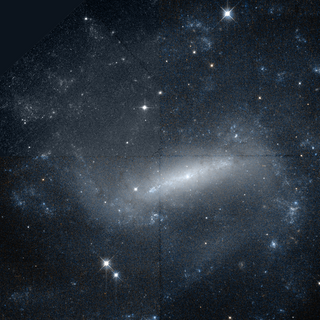 W
WNGC 5964 is a barred spiral galaxy in the constellation Serpens Caput. NGC 5964 is also known by the names IC 4551 and PGC 55637.
 W
WNGC 5970 is a large barred-spiral galaxy located about 90 million light years away in the constellation Serpens Caput. It appears to have two satellite or companion galaxies.
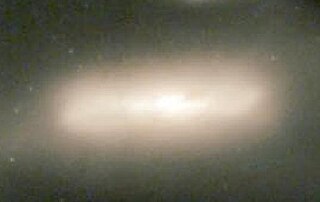 W
WNGC 6027 is a lenticular galaxy that is the brightest member of Seyfert's Sextet, a compact group of galaxies. Édouard Stephan discovered the galaxy in 1882.
 W
WNGC 6027a is a spiral galaxy that is part of Seyfert's Sextet, a compact group of galaxies, which is located in the constellation Serpens. In optical wavelengths, it has a strong resemblance to Messier 104, the Sombrero Galaxy, with which it shares a near equivalent orientation to observers on Earth.
 W
WNGC 6027b is an interacting lenticular galaxy that is part of Seyfert's Sextet, a compact group of galaxies currently in the process of colliding and merging, which is located in the constellation Serpens.
 W
WNGC 6027c is a barred spiral galaxy that is part of Seyfert's Sextet, a compact group of galaxies, which is located in the constellation Serpens.
NGC 6027d is a barred spiral galaxy that is strictly a visual member of Seyfert's Sextet, a compact group of galaxies, which is located in the constellation Serpens. NGC 6027d is not interacting with the other galaxies in the cluster, but is in the background and just happens to be in the same line of sight. The galaxy is nearly 700 million light years away from the interacting group and is believed to be extremely large in size.
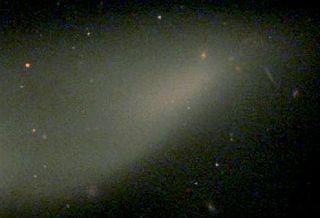 W
WNGC 6027e is a tidal tail of NGC 6027, not an individual galaxy, that is part of Seyfert's Sextet, a compact group of galaxies, which is located in the constellation Serpens.
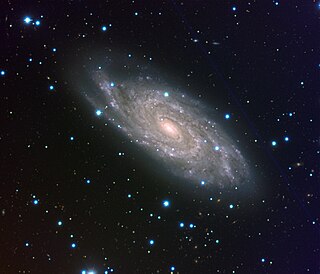 W
WNGC 6118 is a grand design spiral galaxy located 83 million light-years away in the constellation Serpens. It measures roughly 110,000 light-years across; about the same as our own galaxy, the Milky Way. Its shape is classified as "SA(s)cd," meaning that it is unbarred and has several rather loosely wound spiral arms. The large numbers of bright bluish knots are active star-forming regions where some very luminous and young stars can be perceived.
 W
WNGC 6535 is a globular cluster of stars located at a distance of 22,200 light years from Earth in the equatorial Constellation of Serpens, and is listed in the New General Catalogue. It was discovered in 1852 by astronomer John Russell Hind using a 7-inch telescope.
 W
WNGC 6604 is an open star cluster located 5500 light years away in the constellation of Serpens and is located about two degrees north of the Eagle Nebula.
 W
Wν Serpentis, Latinized as Nu Serpentis, is a solitary star in the Serpens Cauda section of the equatorial constellation of Serpens. It is a white-hued star that is faintly visible to the naked eye with an apparent visual magnitude of 4.32. Based upon an annual parallax shift of 16.05 mas as seen from the Sun, it is about 203 light years from the Sun. The star is drifting further away with a radial velocity of +5 km/s.
 W
WPGC 54493 is a barred spiral galaxy located about 490 million light-years away in the constellation Serpens. It is part of a galaxy group called Abell 2052. It has an estimated diameter of 140,000 light-years.
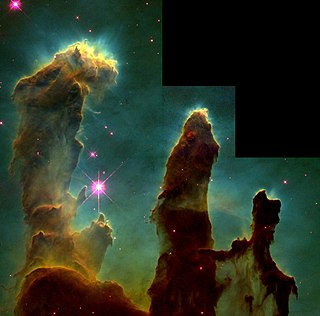 W
WPillars of Creation is a photograph taken by the Hubble Space Telescope of elephant trunks of interstellar gas and dust in the Eagle Nebula, specifically the Serpens constellation, some 6,500–7,000 light years from Earth. They are so named because the gas and dust are in the process of creating new stars, while also being eroded by the light from nearby stars that have recently formed. Taken on April 1, 1995, it was named one of the top ten photographs from Hubble by Space.com. The astronomers responsible for the photo were Jeff Hester and Paul Scowen from Arizona State University. The region was rephotographed by ESA's Herschel Space Observatory in 2011, and again by Hubble in 2014 with a newer camera.
 W
WThe Serpens South star cluster is a relatively dense group of more than 600 young stars, dozens of which are protostars just beginning to form. The cluster is situated in the southern portion of the Serpens cloud. The stars are embedded in a dense filament of interstellar gas, which is part of the giant molecular cloud that has given rise to the cluster of young stars in W40. This entire complex is located at a distance of 1420 light-years from the Earth, and is approximately the same distance as the Serpens Main cluster.
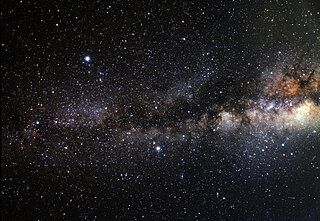 W
WThe Serpens-Aquila Rift (also known as the Aquila Rift) is a region of the sky in the constellations Aquila, Serpens Cauda, and eastern Ophiuchus containing dark interstellar clouds. The region forms part of the Great Rift, the nearby dark cloud of cosmic dust that obscures the middle of the galactic plane of the Milky Way, looking inwards and towards its other radial sectors. The clouds that form this structure are called "molecular clouds", constituting a phase of the interstellar medium which is cold and dense enough for molecules to form, particularly molecular hydrogen (H2). These clouds are opaque to light in the optical part of the spectrum due to the presence of interstellar dust grains mixed with the gaseous component of the clouds. Therefore, the clouds in the Serpens-Aquila Rift block light from background stars in the disk of the Galaxy, forming the dark rift. The complex is located in a direction towards the inner Galaxy, where molecular clouds are common, so it is possible that not all components of the rift are at the same distance and physically associated with each other.
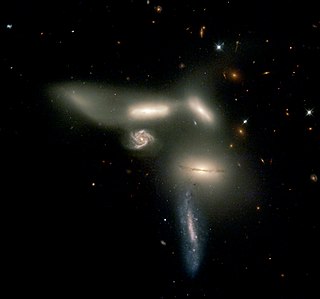 W
WSeyfert's Sextet is a group of galaxies about 190 million light-years away in the constellation Serpens. The group appears to contain six members, but one of the galaxies, NGC 6027d, is a background object and another "galaxy," NGC 6027e, is actually a part of the tail from galaxy NGC 6027. The gravitational interaction among these galaxies should continue for hundreds of millions of years. Ultimately, the galaxies will merge to form a single giant elliptical galaxy.
 W
WSh2-54 is an extended bright nebula in the constellation of Serpens.
 W
WWesterhout 40 or W40 is a star-forming region in our galaxy located in the constellation Serpens Cauda. In this region, interstellar gas forming a diffuse nebula surrounds a cluster of several hundred new-born stars. The distance to W40 is 436±9 pc, making it one of the closest sites of formation of high-mass O- and B-type stars. The Ionizing radiation from the massive OB stars has created an H II region, which has an hour-glass morphology.